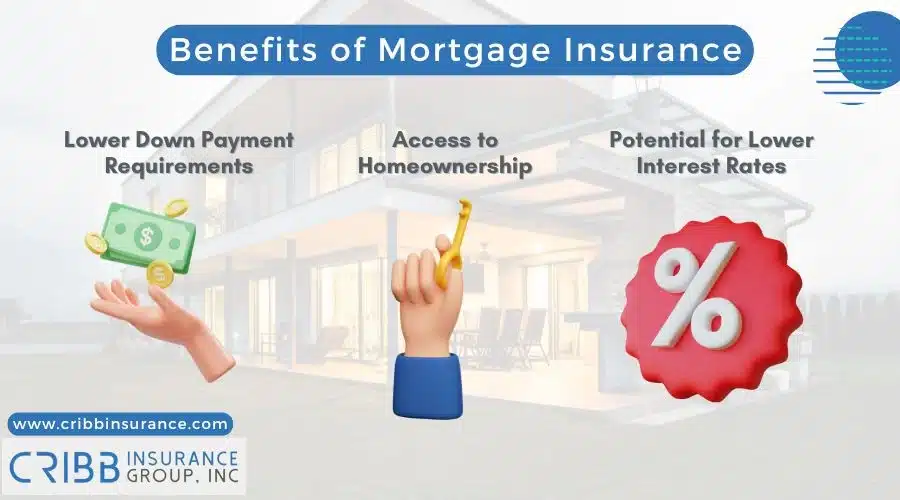Dreaming of buying a home but worried about the large down payment? Mortgage insurance could be the key to unlocking homeownership for you. Understanding mortgage insurance is crucial whether you’re buying your first home or refinancing. It not only influences your loan terms but also affects your overall costs. This guide will break down the purpose of mortgage insurance, how it works, and the various types available so you can make an informed decision about your home loan.

Key Terms You Need to Know
- Private Mortgage Insurance (PMI): Required for conventional loans when the down payment is less than 20%.
- Mortgage Insurance Premium (MIP): Used for FHA loans, involves upfront and annual payments.
- Lender-Paid Mortgage Insurance (LPMI): The lender pays for the insurance, but the cost is passed to you through a higher interest rate.
By understanding these terms upfront, you’ll be better equipped to navigate your mortgage options.
Purpose of Mortgage Insurance: Why It Matters
Mortgage insurance is critical in making homeownership more accessible, especially for those unable to make large down payments. Here’s why it’s important:
- Protects Lenders: Mortgage insurance protects lenders when borrowers can’t make payments, allowing lenders to offer loans with smaller down payments.
- Helps Borrowers: By reducing the lender’s risk, mortgage insurance opens the door for buyers who might not have a full 20% down payment.
- Facilitates Access to Loans: If you can’t afford a 20% down payment, mortgage insurance can help you qualify for a loan and allow you to own a home.
Understanding the purpose of mortgage insurance helps you make informed decisions about your mortgage options and financial planning.
How Mortgage Insurance Works: A Simple Overview
Mortgage insurance protects the lender if you miss mortgage payments. Here’s how it works:
- Monthly Premiums: Most mortgage insurance is paid monthly. This premium is added to your mortgage payment and covers the insurance costs.
- Upfront Payments: Some types of mortgage insurance, like FHA loans, require an upfront payment at closing. This one-time fee covers part of the insurance cost.
- Coverage Duration: The duration of mortgage insurance depends on the type of loan and your down payment. For conventional loans, you may be able to cancel mortgage insurance once you reach 20% equity in your home. For FHA loans, insurance might be required for the life of the loan.
Mortgage Insurance: What You Need to Know
There are different types of mortgage insurance, each with its features and requirements. Here’s a breakdown of the most common types:
Private Mortgage Insurance (PMI):
- What It Is: PMI is typically required for conventional loans when your down payment is less than 20%.
- Cost: The cost of PMI varies but usually ranges from 0.3% to 1.5% of the original loan amount annually.
- Removal: PMI can be removed once you have built up 20% equity in your home.
Mortgage Insurance Premium (MIP):
- What It Is: MIP is used for FHA loans, which are backed by the Federal Housing Administration.
- Cost: FHA loans require both an upfront MIP (1.75% of the loan amount) and an annual MIP that ranges from 0.45% to 1.05%.
- Duration: MIP may be required for the life of the loan, though it can be removed if you put down 10% or more.
Lender-Paid Mortgage Insurance (LPMI):
- What It Is: With LPMI, the lender pays for the insurance but increases your interest rate to cover the cost.
- Cost: Your interest rate will be higher, but you won’t have a separate mortgage insurance payment.
- Removal: LPMI cannot be canceled unless you refinance your mortgage.
When Mortgage Insurance is Required: Key Scenarios
Mortgage insurance is typically required in the following situations:
- Low Down Payment Loans: If you make a down payment of less than 20% on a conventional loan, you will likely need PMI.
- FHA Loans: All FHA loans require MIP, regardless of your down payment amount.
- Refinancing: PMI may be required if you refinance into a conventional loan with less than 20% equity.
- High-Risk Situations: If you have a lower credit score or a higher loan-to-value ratio, you may face higher insurance costs or requirements.
How to Avoid Mortgage Insurance: Tips and Strategies
Paying mortgage insurance isn’t always unavoidable. Here are strategies to help you skip this extra cost:
- Make a Larger Down Payment: The simplest way to avoid mortgage insurance is to put down at least 20% on a conventional loan.
- Consider VA or USDA Loans: These government-backed loans don’t require mortgage insurance but may have other fees or requirements.
- Look for Special Programs: Some lenders offer loans with no mortgage insurance, though they may come with higher interest rates or stricter terms.
- Explore Piggyback Loans: A piggyback loan involves taking out a second loan to cover part of your down payment, helping you avoid mortgage insurance on the first loan.

Benefits of Mortgage Insurance: Why It Can Be Helpful
Mortgage insurance can be beneficial in several ways:
Lower Down Payment Requirements
Benefit: Mortgage insurance allows you to purchase a home with a smaller down payment. This is especially helpful for first-time buyers or those with little savings.
Access to Homeownership
Benefit: It opens up homeownership to individuals who might not otherwise qualify for a loan due to a lack of a large down payment.
Potential for Lower Interest Rates
Benefit: Some lenders may offer lower interest rates on loans with mortgage insurance compared to high-risk loans without insurance.
Myths and Realities: Expanding Your Knowledge
Mortgage insurance is often misunderstood. Here are some common myths:
Myth: Mortgage Insurance Only Benefits the Lender
Reality: While it protects lenders, mortgage insurance also helps borrowers get approved for a loan they might otherwise not qualify for. For example, many first-time homebuyers with limited savings can still purchase a home thanks to mortgage insurance, allowing them to start building equity instead of paying rent.
Myth: You’ll Pay PMI Forever
Reality: PMI on conventional loans can be canceled once you reach 20% equity. It’s not always a lifetime commitment. In fact, many homeowners successfully remove PMI after a few years, significantly if their home value increases or they make extra payments toward their mortgage.
Myth: Mortgage Insurance Is an Unnecessary Cost
Reality: Mortgage insurance can be beneficial. It allows buyers to enter the housing market sooner by lowering down payment requirements, providing a pathway to homeownership for those who don’t have 20% saved up.
Impact on Mortgage Approval: How Mortgage Insurance Helps
Mortgage insurance plays a significant role in the mortgage approval process:
Increased Loan Approval Chances
Impact: Mortgage insurance reduces lenders’ risk, making it easier for you to get approved for a loan, even with a smaller down payment.
Enhanced Loan Flexibility
Impact: With mortgage insurance, lenders might be more willing to offer flexible terms or approve higher loan amounts.
Improved Loan Conditions
Impact: Having mortgage insurance can sometimes lead to more favorable loan conditions than high-risk loans with no insurance.
Comparison of Mortgage Insurance Policies: Choosing the Right One
When choosing a mortgage insurance policy, consider the following comparisons:
PMI vs. MIP:
Comparison: PMI is for conventional loans and can be removed once you reach 20% equity. MIP is for FHA loans and may be required for the life of the loan.
Monthly vs. Upfront Costs:
Comparison: PMI often involves monthly payments, whereas MIP includes an upfront cost and ongoing annual payments.
Lender-Paid vs. Borrower-Paid:
Comparison: Lender-paid mortgage insurance (LPMI) raises your interest rate but eliminates separate insurance payments, while borrower-paid insurance involves a separate monthly payment but may have lower rates.

Alternatives to Mortgage Insurance: What Are Your Options?
If you’re looking to avoid mortgage insurance, there are several alternatives:
VA Loans:
Alternative: VA loans, backed by the U.S. Department of Veterans Affairs, don’t require mortgage insurance. They are available to veterans and active military members and offer favorable terms.
Pros: No down payment required, no mortgage insurance, and competitive interest rates.
Cons: Available only to qualified veterans and military members, funding fees may apply.
USDA Loans:
Alternative: USDA loans, provided by the U.S. Department of Agriculture, are designed for rural areas and do not require private mortgage insurance. They come with a low upfront fee and an annual fee.
Pros: No mortgage insurance and minimal down payment required.
Cons: Only available for properties in eligible rural areas, and the income limits apply.
Piggyback Loans:
Alternative: A piggyback loan involves taking out a second loan to cover part of the down payment. This can help you avoid mortgage insurance by keeping the first loan below 80% of the home’s value.
Pros: Avoids mortgage insurance and reduces monthly costs.
Cons: Requires good credit and a second loan, which can be more complicated to manage and potentially cost more in interest over time.
Is Mortgage Insurance Right for You?
Mortgage insurance offers both pros and cons. It can make homeownership accessible with a smaller down payment, but it also adds to your monthly costs. Here’s a summary to help you decide:
Benefits:
- Allows for lower down payments.
- Increases chances of loan approval.
- Can offer access to better loan terms.
Considerations:
- Adds an additional monthly expense.
- Might be required for the entire loan term, depending on the type.
Frequently Asked Questions
How is mortgage insurance different from homeowners insurance?
Mortgage insurance protects the lender if you default on your loan, while homeowners insurance covers damages to your home and belongings. They serve different purposes.
Can I cancel mortgage insurance before reaching 20% equity?
In some cases, you may be able to cancel mortgage insurance before reaching 20% equity if your home value has increased significantly. Check with your lender for specific requirements.
What happens to mortgage insurance if I refinance my home?
When you refinance, you may be able to remove or adjust mortgage insurance, depending on your new loan terms and equity in the home.
Does mortgage insurance cover repairs or damages to my home?
No, mortgage insurance does not cover home repairs or damages. It only protects the lender if you fail to make mortgage payments.
What factors affect the cost of mortgage insurance?
Factors include your down payment size, loan amount, credit score, and type of mortgage insurance (e.g., PMI or MIP). Higher risk factors typically lead to higher costs.
How can I find out if I need mortgage insurance?
Your lender will determine if you need mortgage insurance based on your down payment and loan type. They will inform you if it is required for your mortgage.
Explore Your Mortgage Options Today
Ready to move forward with homeownership? Here’s how you can get started:
- Calculate Your Costs: Use online calculators to estimate your mortgage insurance costs and see how they fit into your budget.
- Consult with Lenders: Speak with multiple lenders to explore different mortgage options and find the best rates and terms.
- Review Alternatives: Consider alternatives to mortgage insurance to see if they might better suit your needs.
Take the next step towards homeownership with Cribb Insurance Group Inc by exploring your mortgage options and finding the right solution.





